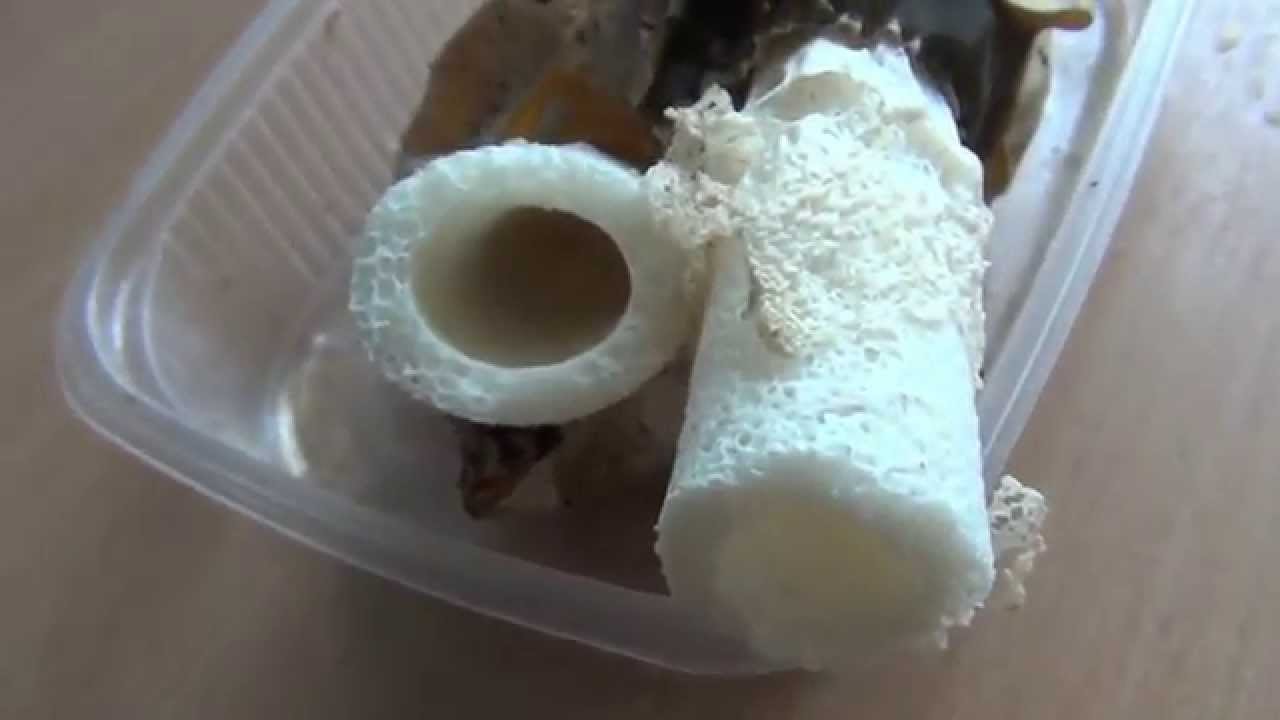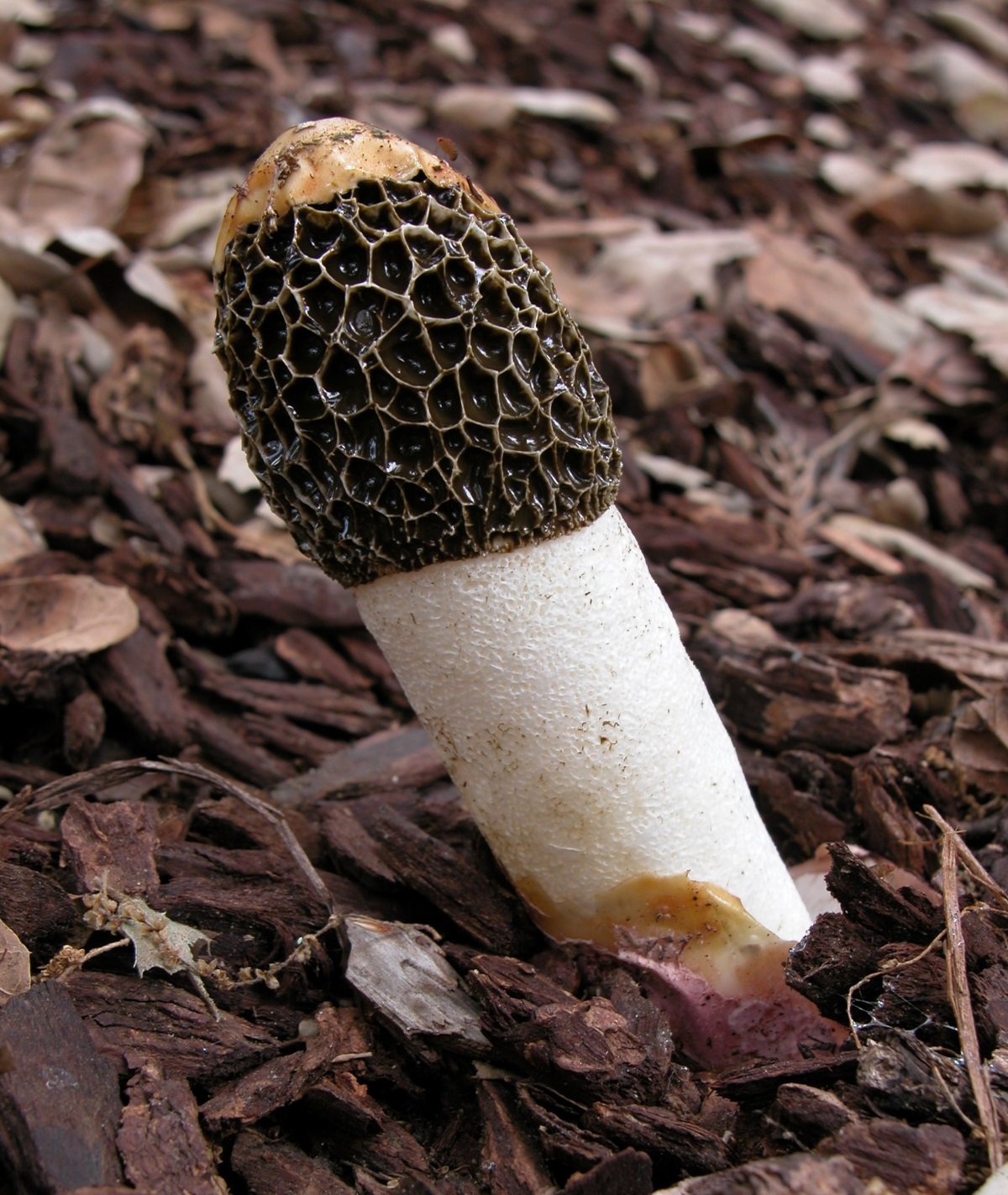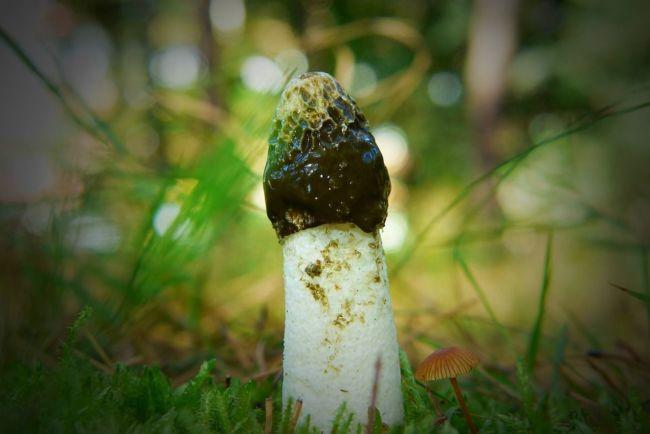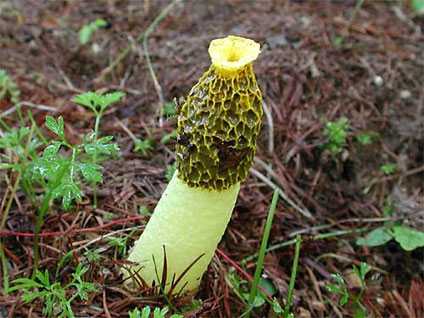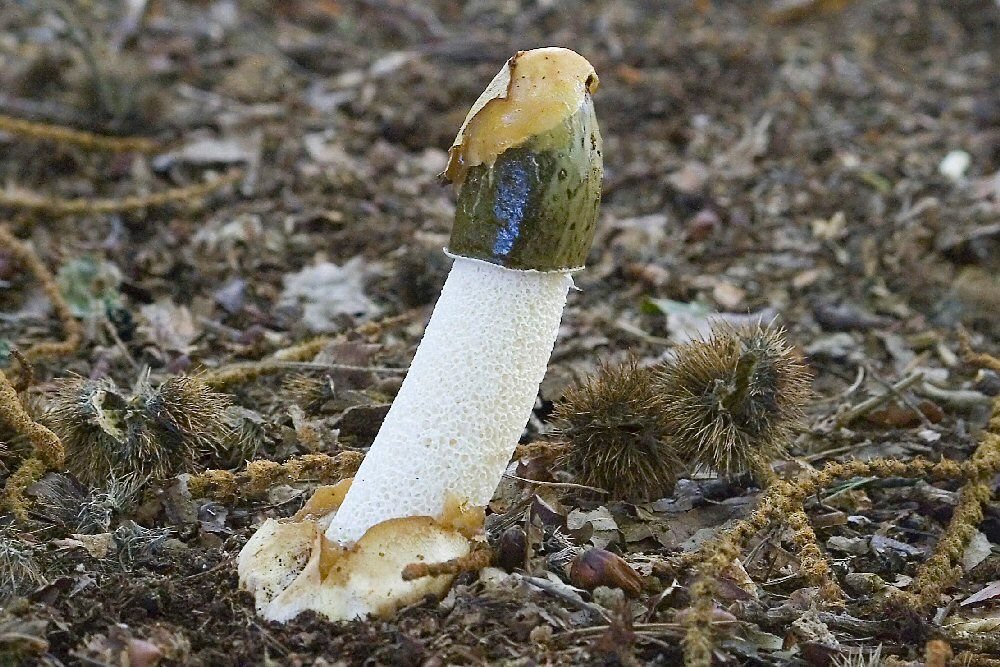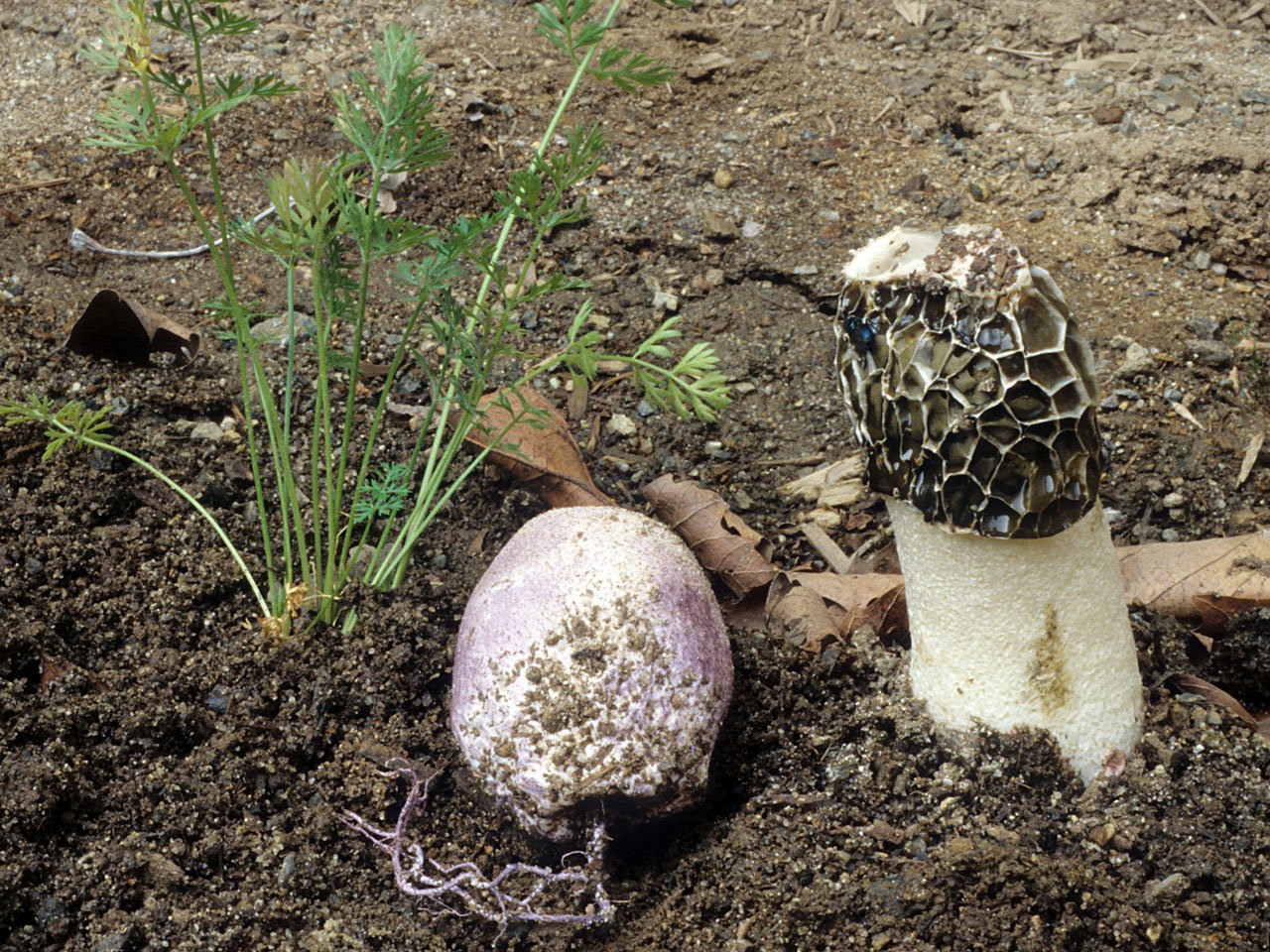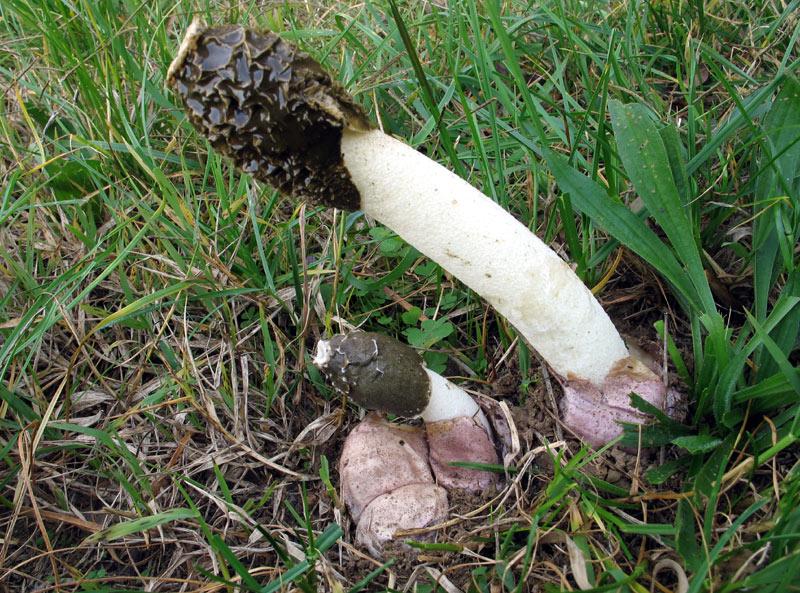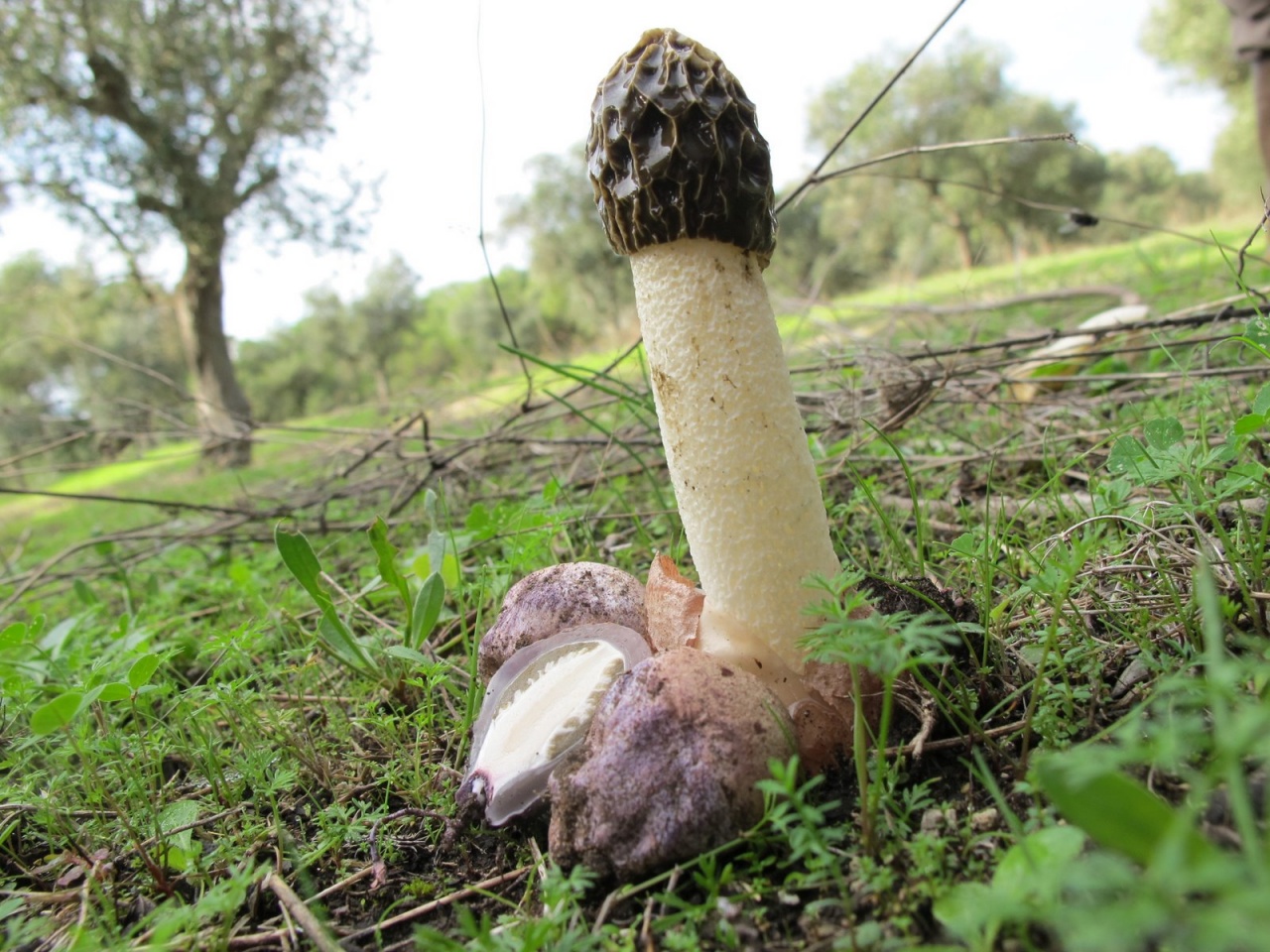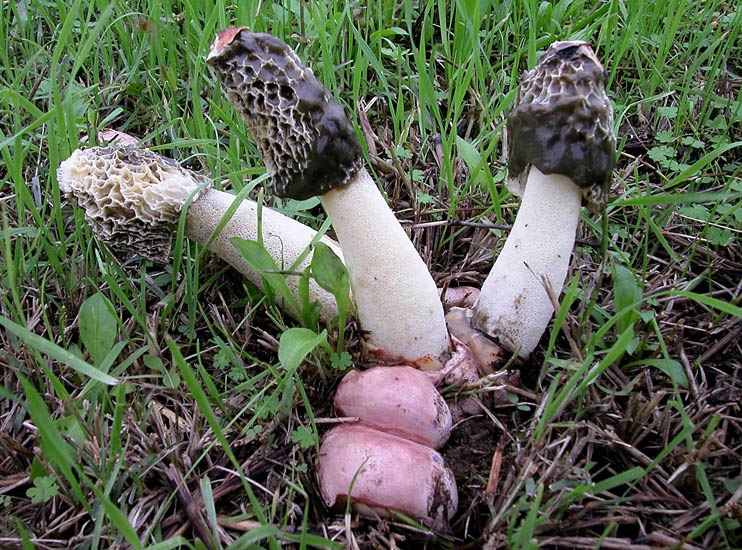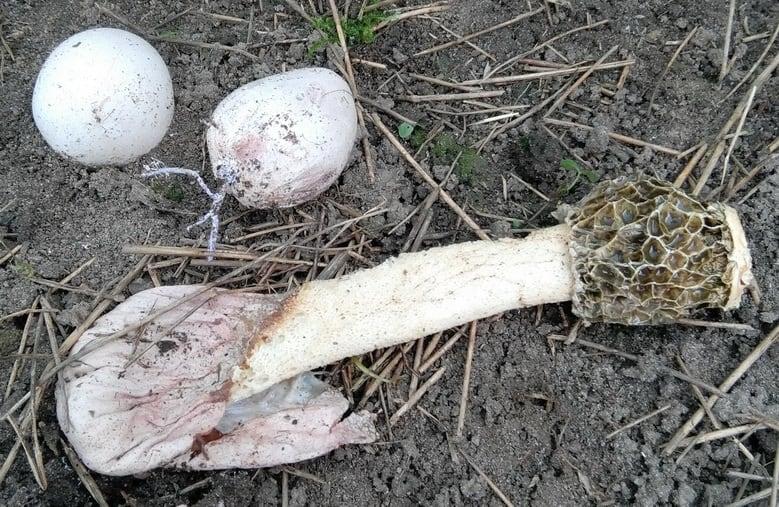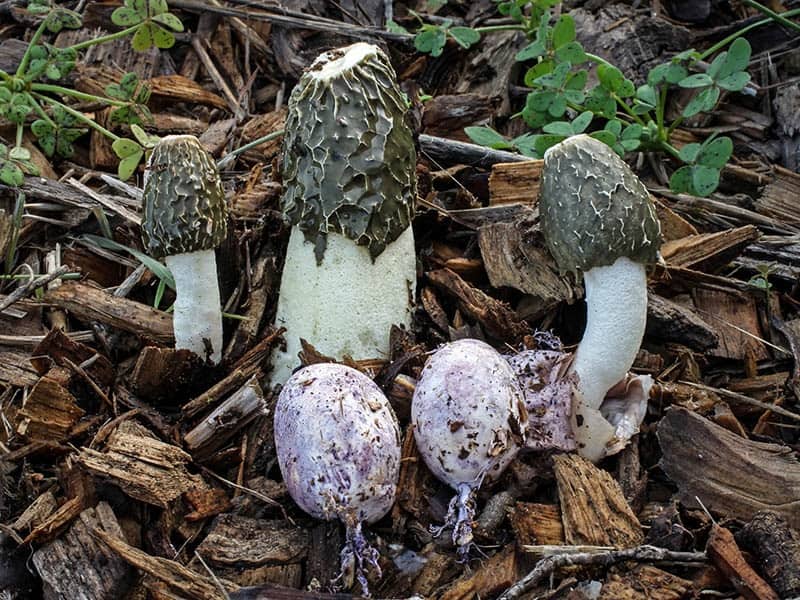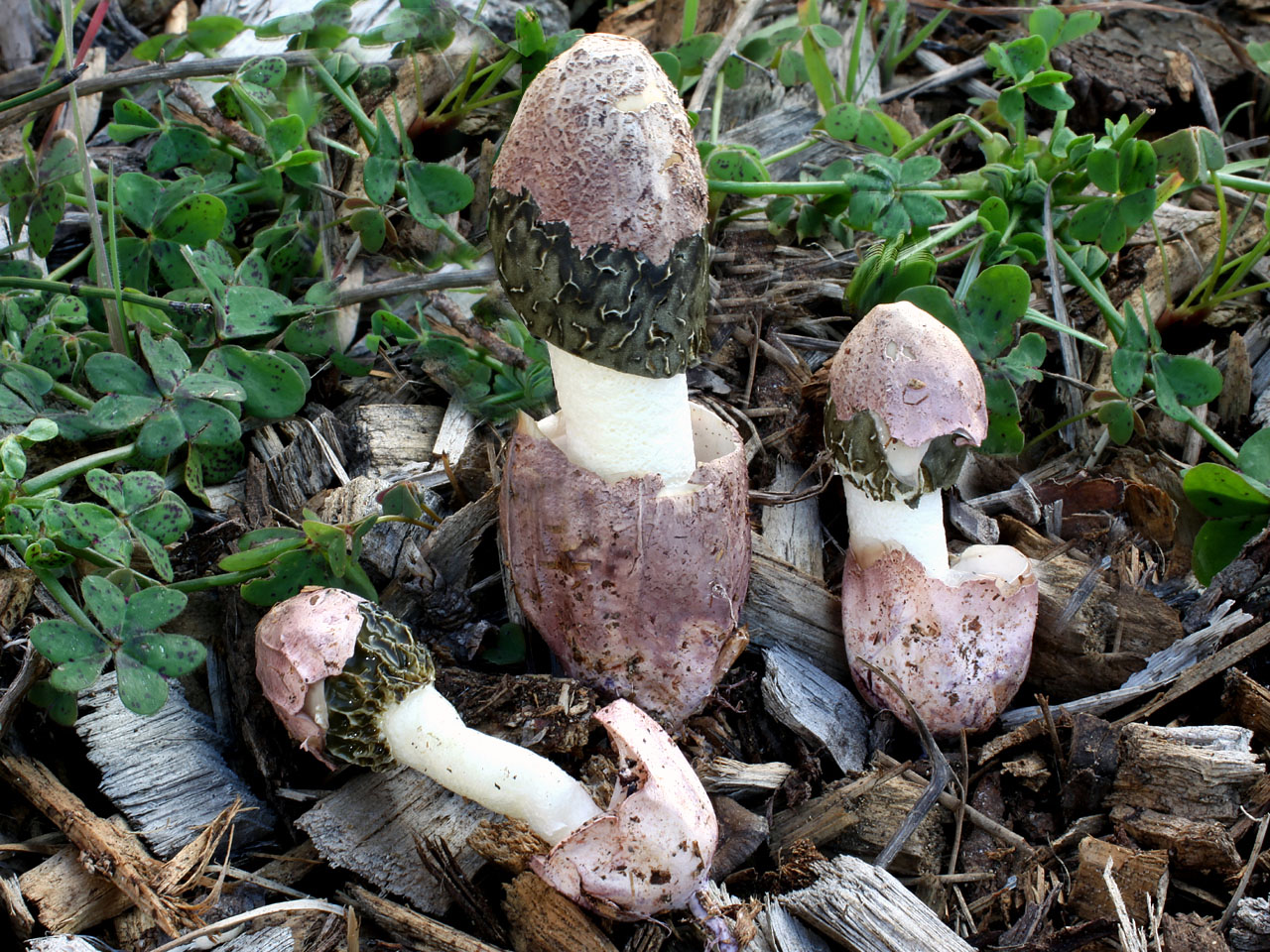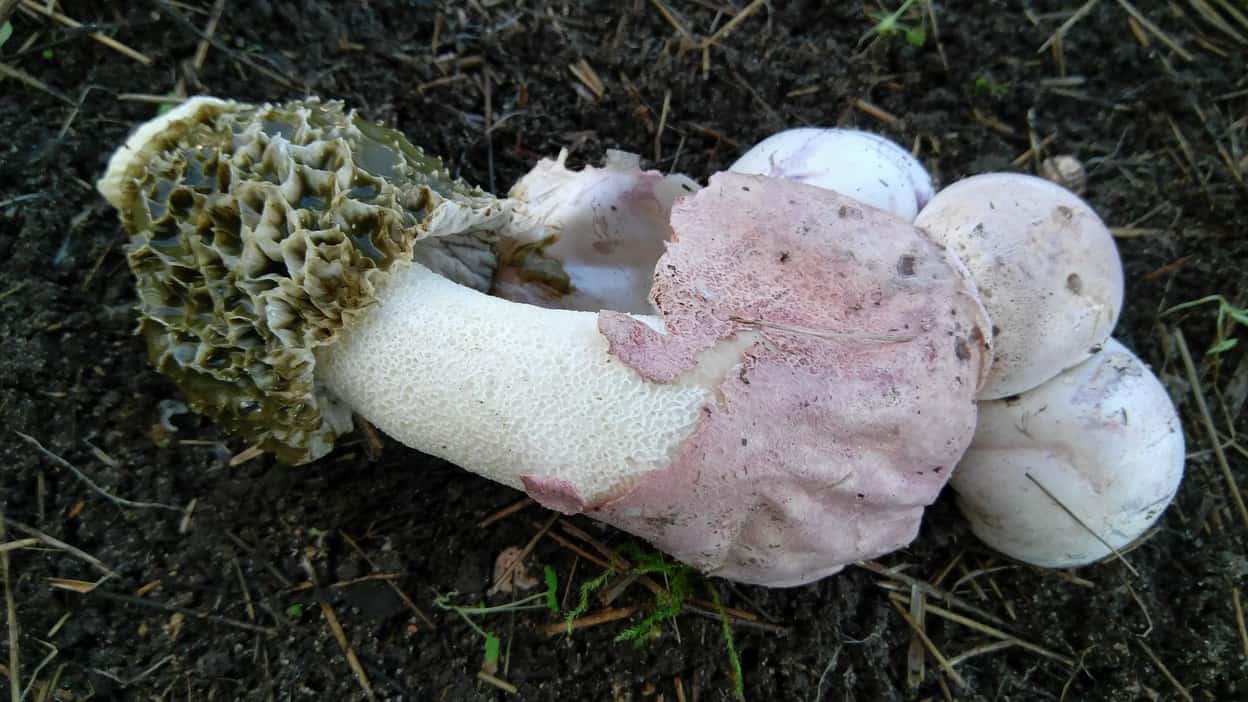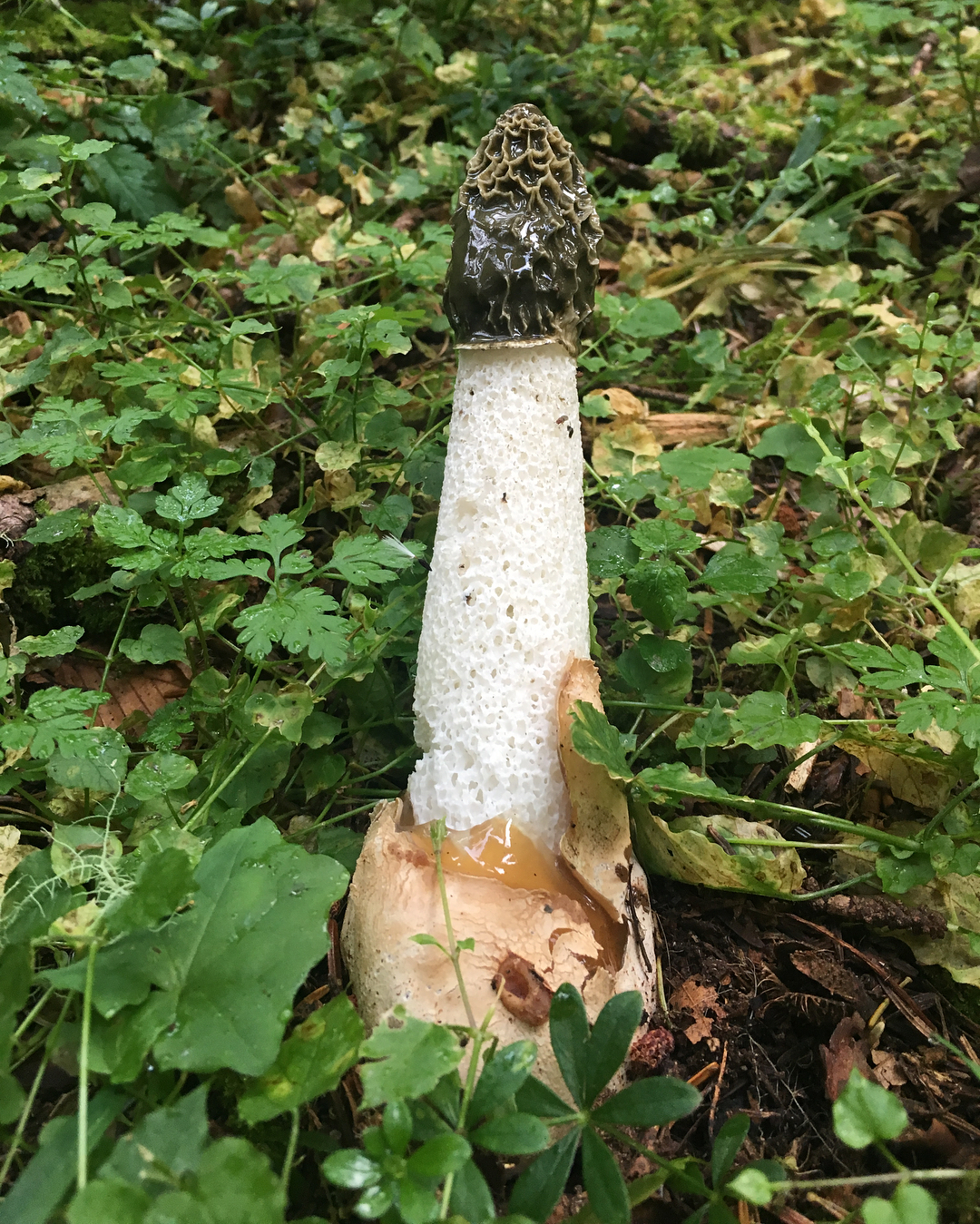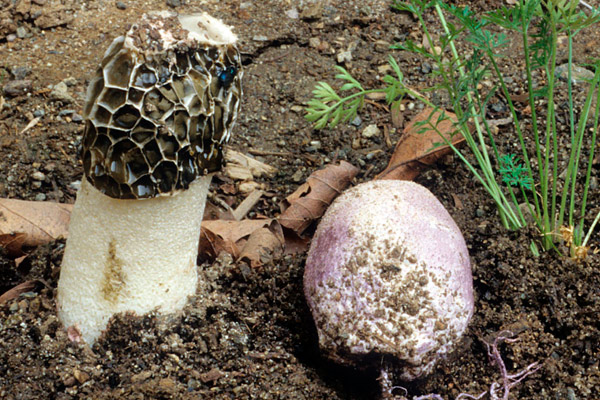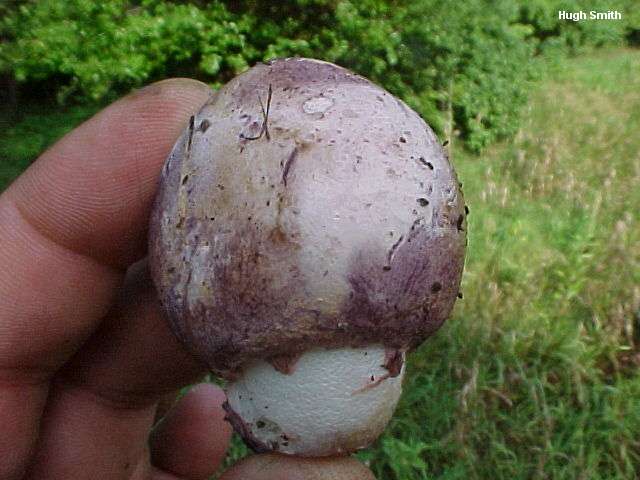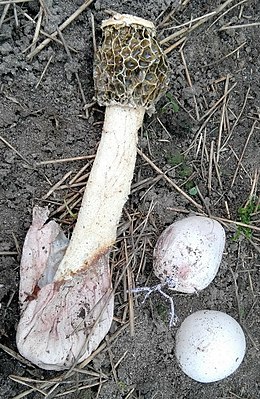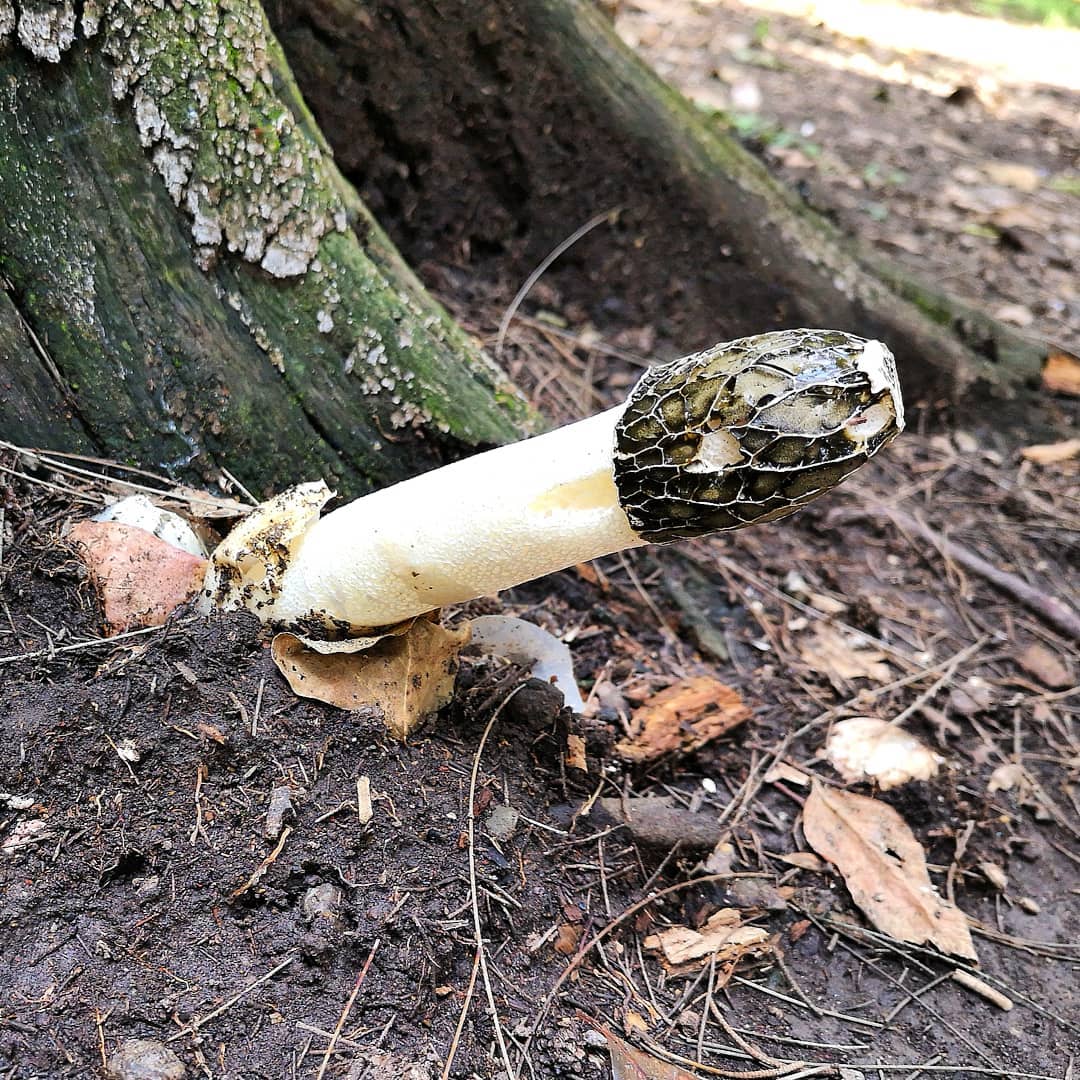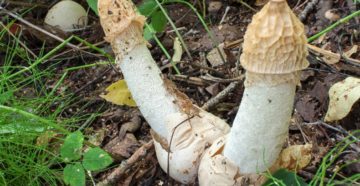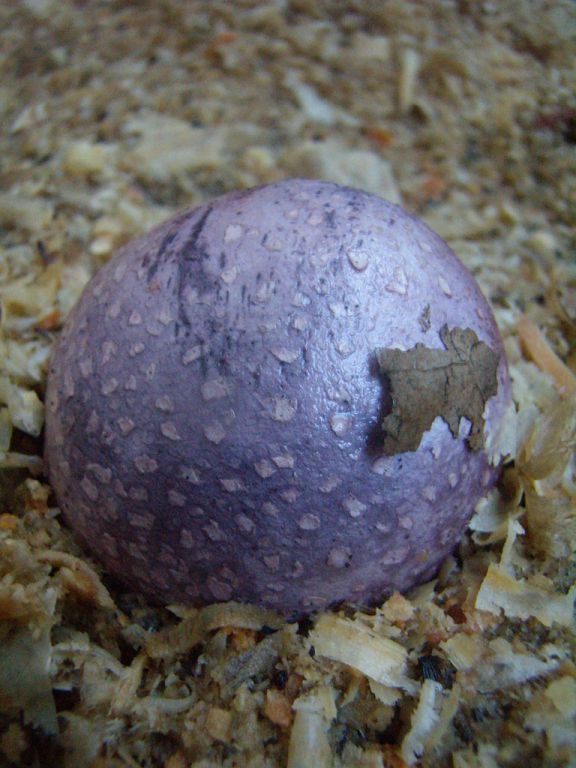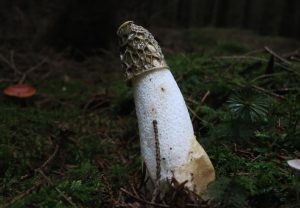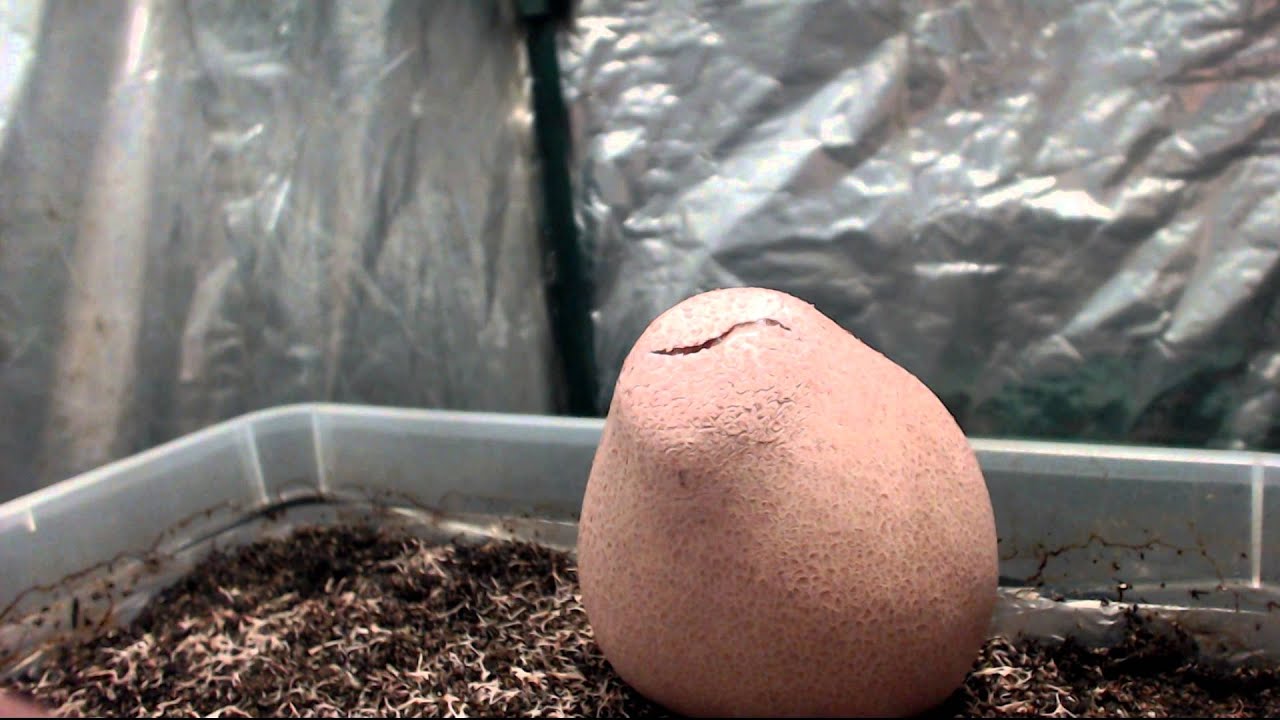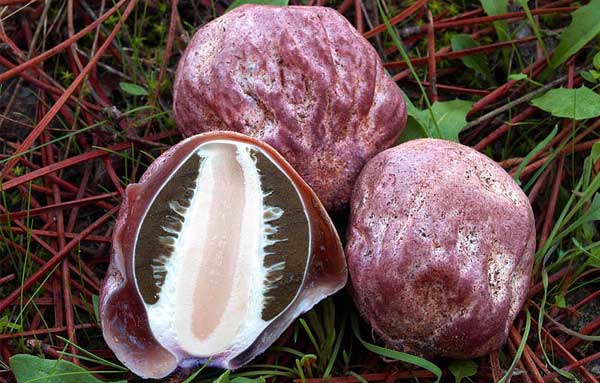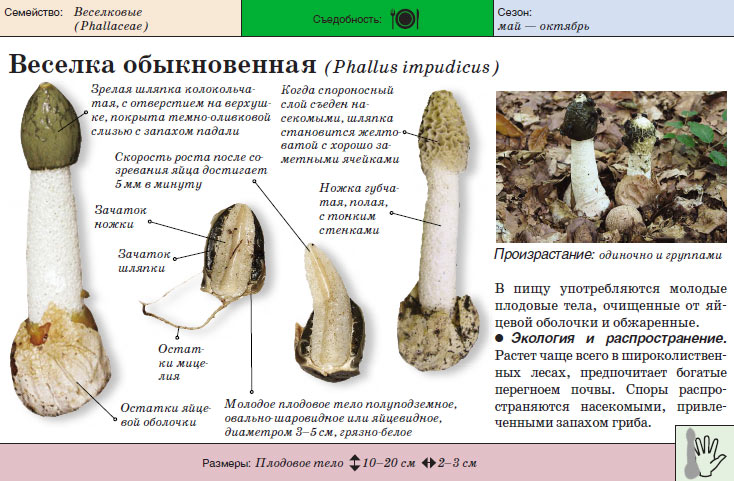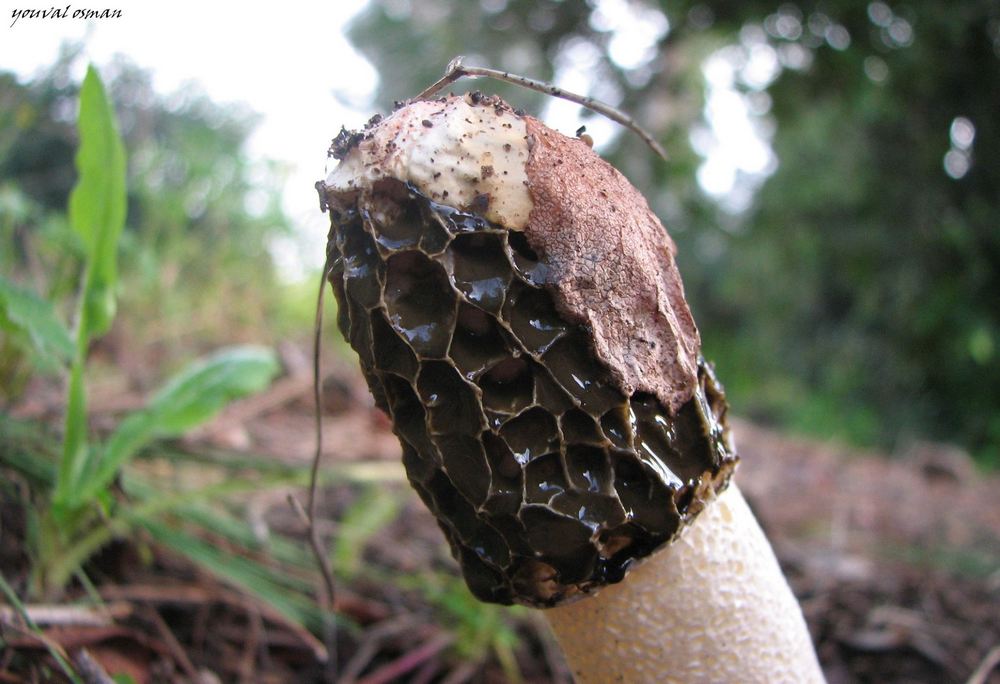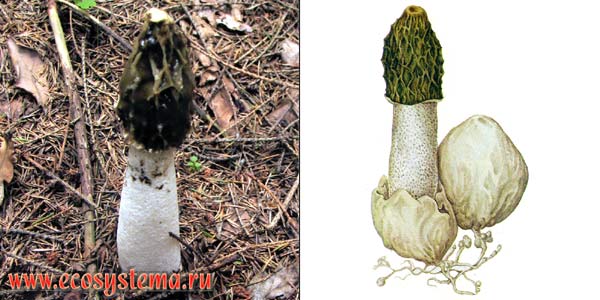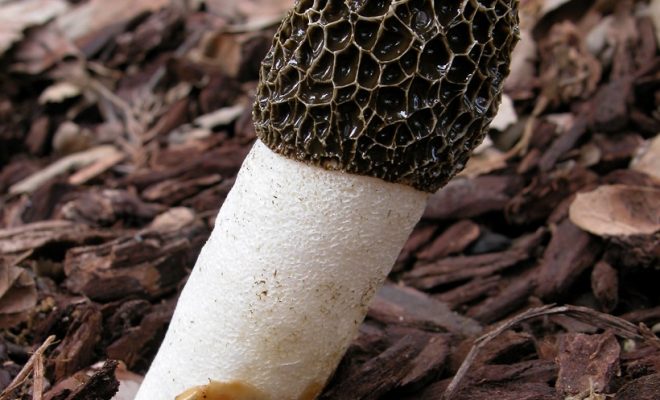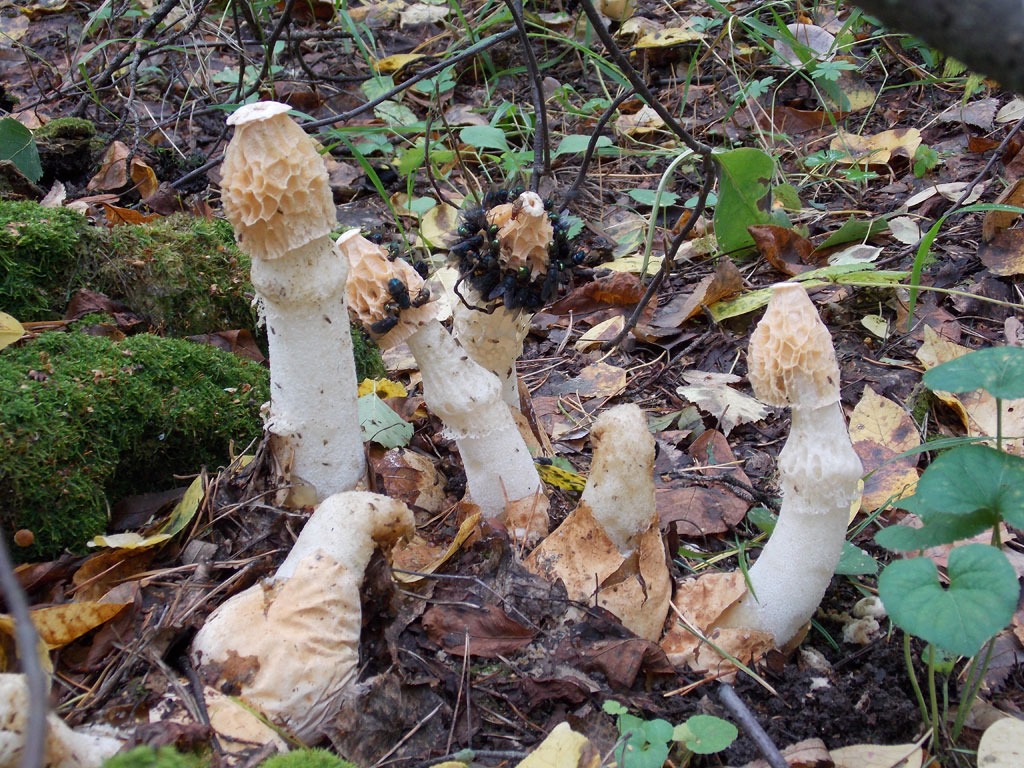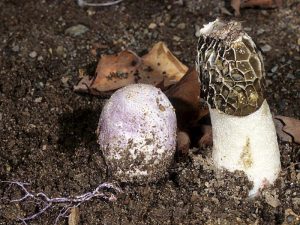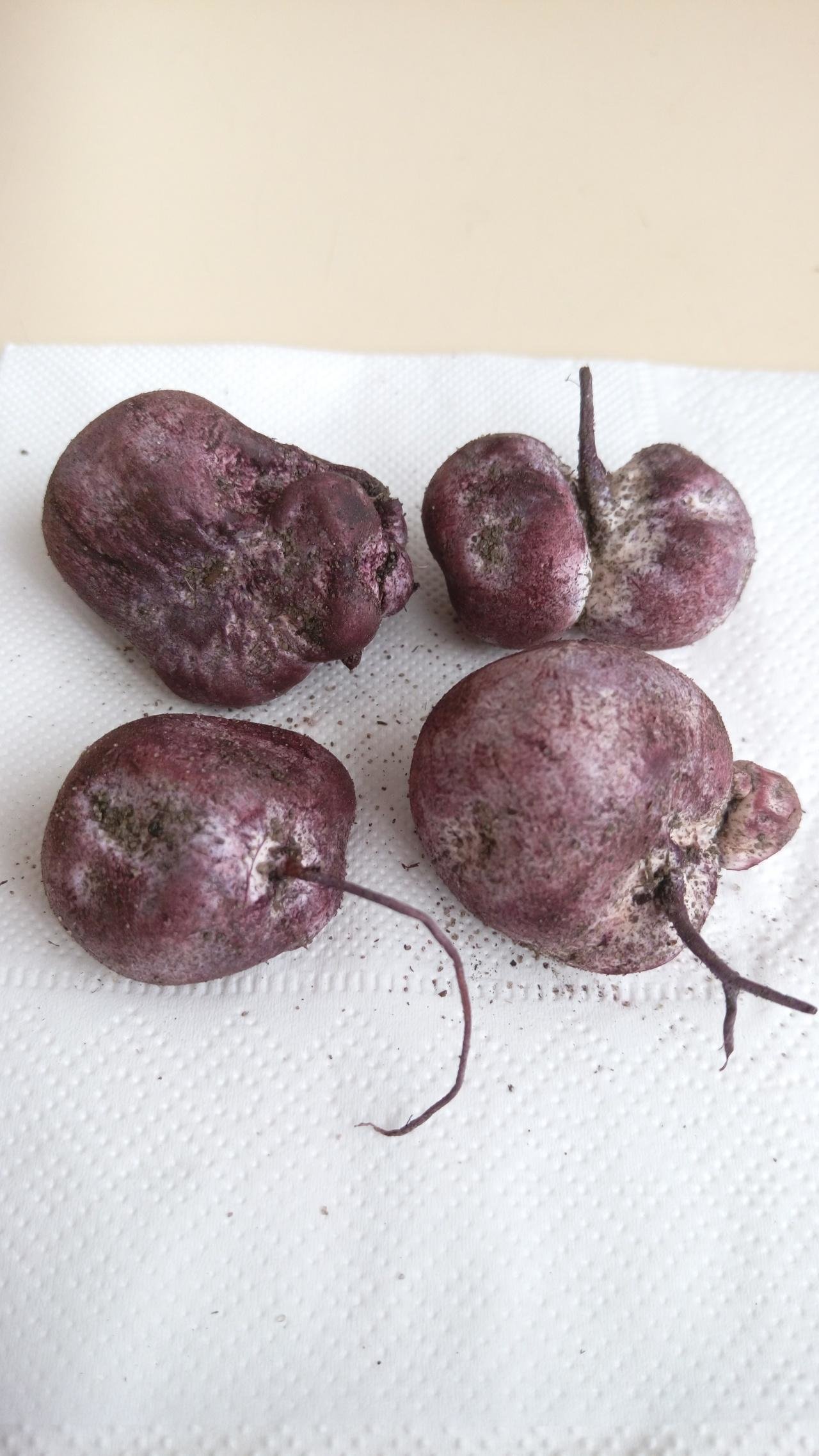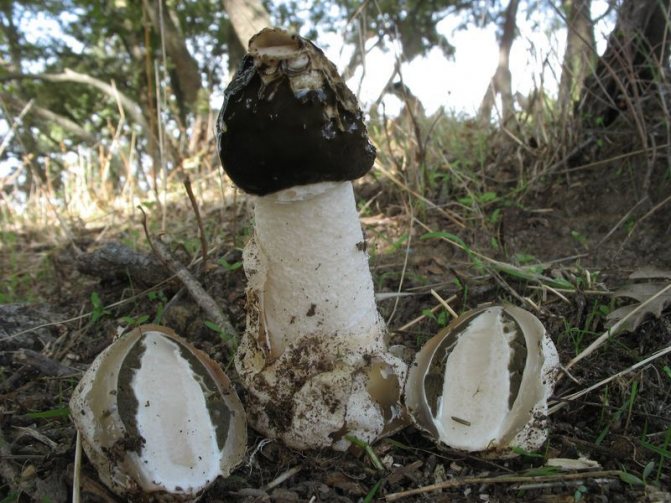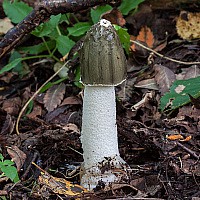Veselka Ravenelli (Phallus ravenelii)
Synonyms:
Aedycia ravenelii
Veselka Ravenelli (Phallus ravenelii) is a mushroom that belongs to the Veselkov family and the Phallus genus (Veselok).
External description
Initially, the shape of the Veselka Ravenelli (Phallus ravenelii) resembles a pinkish, lilac or purple egg. The "egg" develops rapidly, grows in breadth, and as a result, a fruiting body, shaped like a phallus, grows out of it. The yellowish-white stem of the mushroom is crowned with a cap the size of a thimble. Its width varies from 1.5 to 4 cm, and its height is from 3 to 4.5 cm. The total height of the fruiting body can reach 20 cm. The surface of the cap of Veselka Ravenelli (Phallus ravenelii) is fine-grained, and its edges are connected to the stem by a peri-cap ring. In some specimens, the cap is too wide and becomes tapered. the color of the cap in different specimens can vary from olive green to dark brown.
The mushroom leg is hollow, it can reach 10-15 cm in height, and its diameter varies within 1.5-3 cm. It is white or whitish-yellow in color.
Veselka Ravenelli's spores (Phallus ravenelii) are characterized by thin walls and a sticky surface, elliptical, smooth, colorless, 3-4.5 * 1-2 microns in size.
Season and habitat of the mushroom
Veselka Ravenelli (Phallus ravenelii) is widespread in eastern North America. Dominates other species west of the Mississippi, found in Costa Rica.
The described species belongs to saprbiotics, therefore it can grow in any habitat where rotting wood is present. The fungus grows well on rotten stumps, wood chips, sawdust. Veselka Ravenelli can often be seen in groups, but there are also specimens growing separately. the species is also common in city flower beds, lawns, meadows, park areas, forests and fields.
Edibility
Veselki Ravenelli (Phallus ravenelii) are considered edible only at a young age, when they look like an egg. Mature specimens exude an unpleasant odor, so seasoned mushroom pickers prefer not to collect them for food.
Similar types and differences from them
Merry Ravenelli (Phallus ravenelii) is often confused with Phallus impudicus and Phallus Hadriani. P. Impudicus differs from the described species in the net structure of the cap, the surface of which is covered with alternating grooves and ridges. As for the main difference of the P. Hadriani species, it consists in the presence of seeds on the cap. This species, in contrast to the Ravanelli merry, can be found very rarely.
Another similar mushroom belongs to the species Itajahya galericulata. It has a spherical cap, the surface of which is covered with several layers of spongy tissue, between which a loose inner tissue - gleb - is sandwiched.
The next species, similar to the one described, is called Phallus rugulosus. This mushroom is thin, it has a higher height, a light orange color of the fruiting body, a stem that tapers near the cap and a smooth surface of the cap itself. It grows in China, as well as in the southern and eastern parts of the United States.
granulosodenticulatus is a species of Brazilian mushroom that is rare and similar to Ravanelli in appearance. Its fruiting bodies are smaller and do not exceed 9 cm in height. The cap has a serrated edge, and the spores are large, measuring 3.8-5 * 2-3 microns.
Other information about the mushroom
Mushroom gleb gives off a characteristic unpleasant odor that attracts insects to the plant. they sit on sticky, spore-bearing areas of the fruiting body, eat, and then transfer fungal spores on their paws to other places.
Time and place of fruiting
Double netting appears in deciduous forests on decayed wood or humus-covered soil. It grows both in groups and singly. Fruiting time is from July to September, but irregularly.
Location in Russia:
- Moscow region;
- Kaluga region;
- Kirov region;
- Belgorod region;
- Republic of Adygea;
- North Ossetia Alania;
- Novosibirsk region;
- Tomsk region;
- Krasnoyarsk region;
- Irkutsk region;
- The Republic of Khakassia;
- The Republic of Buryatia;
- Khabarovsk region;
- Central Black Earth Region;
- Primorsky Krai.
REFERENCE! Besides the RF, the mushroom can be found in Africa, Europe, Asia and North America.
A brief description of the conditionally edible mushroom
Double nets (or double Diktyophora) is a mushroom of the Veselka genus, Veselkovye class, Agaricomycetes family. The Latin name for the phallomycete species is Phallus duplicatus, Dictyophora duplicata. In the adult state, the double mesh nose gives off a sharp, unpleasant odor for a person, therefore, only young specimens are recommended to be eaten.
The fungus looks like an ovoid fruiting body (4–5 cm in diameter) with a smooth surface. The shade of the doubled mesh varies from white and yellow to brown. The fungus creates a cap after the shell covering the fruit egg breaks. The leg of the jellyfish is white, spongy and hollow inside, reaching a length of 20 cm. The hat area up to 3–5 cm in size has the shape of a cone and acquires an olive tint with age.
From under the cap, almost to the base of the leg, a white patterned mesh formation of a conical shape peeps out. This is a "veil", later it acquires a light brown hue with pink or greenish blotches, and at night it glows with an emerald color.
The double netkonoska is listed in the Red Book of Russia, the Moscow region. The reasons contributing to the decrease in the number of the fungus are still poorly understood. Perhaps the disappearance of the species is associated with a change in temperature.
A bit of history
For the first time the word Fallus was used by the doctor from the Netherlands Adrian de Jonge in 1562. And in 1792 the Italian botanist Pierre Micheli published an article in which he described the genus Fallus and 2 species of mushrooms included in it. In 1801, the Dutch scientist Person added a number of species by talking about them in his work. Gradually, the genus of fun was replenished - in 1811, a double net was added.
Double mesh
Double mesh - Dictyophora duplicata
In another way, this fungus is called Dictyophora double or double Phallus.
External characteristics
At the initial stage of growth, the fungus is an ovoid fruiting body, which is partially in the soil and reaches 60-80 mm. It is covered with a white shell with a mealy bloom. Over time, it acquires a yellowish (brownish) hue, and, torn into several parts, “releases” a mushroom with a stem and a cap.
Mushroom cap
Diktyophora double has honeycomb - ribbed hats in the form of cones, covered with green - olive mucus and reaching 30-50 mm in width and height. The tips of the hats have small round holes.
When a mushroom is born full-length, it emits a sickening smell of carrion, which attracts insects: they eat mucus and spread spores.
Stipe
The double nets have an empty stem in the form of a cylinder, tapering towards the base and the hat, and growing up to 20-30 mm in thickness and 15-25 cm in length.
The bottom of the leg retains traces of the torn shell of the ovoid body. From the hat to the middle or to the very bottom, the leg is surrounded by a beautiful openwork veil, as if knitted from round cells. At first it is snow-white, later it turns into a pale brown color with a greenish or pinkish tint. The bedspread glows green at night.
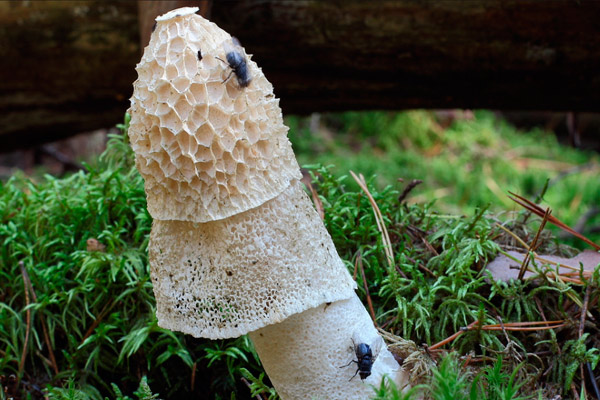
Double nets - Dictyophora duplicata
Growing places
The fungus prefers the fertile soil of deciduous and mixed forests of Russia, and willingly grows on half-rotten wood remains.
Fruiting occurs singly or in small groups of a maximum of six mushrooms. It lasts from July to September.
Similar species
The double phallus has similarities with the following conditionally edible cousins:
- Bell-shaped dictyophora. It differs in larger sizes and is found only in South American countries.
- The fun is ordinary. It is distinguished by a brownish-green hat with a honeycomb structure.
- Merry Hadrian. The fruit egg of this species is colored in a purple-pink hue.
All doubles of Diktyophora double do not have an openwork veil that adorns the leg.
Edibility
When the twinned set is in the egg stage, it can be eaten. In its raw form, it is suitable for eating only after removing the shell: the mushroom is added to salads or eaten with sour cream. If the fungus is intended for frying, the casing is usually left on.
Adult mushrooms that give off a nasty smell are not eaten.
Common jellyfish (Phallus impudicus)
Other names:
- Upstart
- Damn egg
- Witches egg
- Swindler
- Earth oil
- Kokushki

Fruit body of the Veselka: Veselka has two stages of development. The first - the mushroom has an ovoid shape, 3-5 cm wide and 4-6 cm high, the color is off-white, yellowish. There is something slimy under the dense peel of the jelly, and a more rigid structure is felt under the mucus. Veselka stays in the egg stage for a very long time, possibly several weeks. Then the egg cracks, and the egg begins to grow upward at a high speed (up to 5 mm per minute). Soon, a fruiting body with a high (10-15 cm, sometimes more) hollow stem and a small adjoining cap covered with brown-olive mucus is formed. Under the mucus, the cap has a cellular structure, which is noticeable at a more mature age, when the mucus is eaten by flies. Having emerged from the egg stage, the common berry gives off a very strong carrion odor, which attracts insects.
Spore Powder: Dissolved in the brown mucus covering the cap; eating mucus, insects carry spores.
Distribution: Veselka "eggs" appear in mid-July; hat-shaped fruiting bodies develop somewhat later. Grows in grass, bushes, in deciduous woodlands. Obviously prefers rich soil.
Similar species: In stage eggs can be confused with any pseudo-raincoat or other representative of the Veselkovy family; a mature mushroom is so characteristic that it is impossible to confuse it with any other mushroom, even with all the desire.
Edible: It is believed that in the egg stage the mushroom is edible; lovers, presumably, are few. At the same time, it should be noted that veselka is actively used in folk medicine - in particular, as a means that increases potency (which is not surprising, given the characteristic appearance and growth rate of the fungus).
Video about mushroom Veselka ordinary:
Author's remarks: An amazing inconsistency: a vest can lie like an unchanged egg for a month, and then grow twenty centimeters in one night! How many times have I found under the bushes, in the garden, in the field, large mushroom "eggs" filled with suspicious mucus, marked the places, arranged shifts - the veselka did not want to appear. All mushroom dreams, including the craziest ones, came true in the blessed summer of 2003 - Veselka herself found me at the edge of the forest, warning me of her appearance with a suffocating stench. Seeing the shamelessly sticking out beel, I was so surprised that I could not find anything smarter than touching a hat with my finger - my finger stank all day. This is the strength of the jolly!
Hadrian's jolly (Phallus hadriani)

Phallus hadriani is a typical type of mushroom from the genus of the jolly family of the jolly family, named after Adrian Junius (a Dutch physician and scientist of the 16th century). In 1562, Junius first used the word Phallus to refer to a jelly-like mushroom, presumably describing this particular species.
(Pictures are clickable - click to enlarge)
It has many names in different languages due to the appearance of the mushroom: Dune Stinkhorn (English) Homoki szömörcsög (Hungarian) Duinstinkzwam (Dutch) Sromotnik fiołkowy (Polish)
Hadoa Hadriánova (Slovak)
Scientific classification
Kingdom: Mushrooms Department: Basidiomycota Class: Agaricomycetes Order: Merry
Family: Veyolkovye
Genus: Veselka
Style: Adrian's Merry
Description of Adrian's Veselka
Adrian's jaunty is generally very similar to the more common and much more common Phallus impudicus. This is a cap mushroom with a height of 12-20 cm.
The young fruiting body is half hidden in the ground, has an ovoid or spherical shape with a diameter of 4-7 cm, at the base with mycelial strands reaching several mm in thickness and resembling plant roots in appearance.
Peridium (egg shell) - leathery, smooth, folded below.
At the beginning it is white, closer to ripening - purple or pink-violet (this is how it differs from the common jolly).
The intensity of the color increases if you take the egg in your hands, as well as under the influence of unfavorable factors - dry air, sudden changes in temperature, humidity, etc. Inside, Veselka Adrian's egg is filled with gelatinous mucus that has a specific smell of dampness.
The germinated (mature) fruiting body of Phallus hadriani consists of a leg-like receptacle, cylindrical, thickened towards the bottom, hollow inside, with spongy walls, white or yellowish-white, cream color, 12-20 cm high and 3-4 cm in diameter.
At the top of the recipe is a bell-shaped cap 2-5 cm high, with a distinct cellular surface, covered with olive gleb.
Gleb, as the mushroom matures, liquefies, while the mushroom emits a strong nut-yeast odor, reminiscent of the smell of sour dough.
However, some people find this smell pleasant. the cap has a white circle of irregular shape with a hole at the top point.
Insects, using spore-containing mucus, promotes the spread of spores, sometimes over considerable distances. Spores, passing intact through the digestive tract of insects, are expelled along with their feces.
Adrian's Veselyka mushroom is edible at a young age (at the egg stage), however, some sources claim that the mushroom is also edible in adulthood, after its opening.
In this case, when using mature mushrooms for food, it is recommended to wash off the spore-containing mucus, otherwise the dish may turn into the color of a swamp mess.
Habitat where it grows
Adrian's jolly can be found on almost all continents, well, except for South America and the poles. The mushroom is found in Europe (Denmark, Ireland, the Netherlands, Latvia, Poland, Norway, Slovakia, Sweden, Ukraine, Belarus), in Asia (Turkey, Japan , China) and North America.
In Australia, too, here it is considered imported from Europe. On the territory of Russia, it comes across most often in the southern regions of the European part (Eastern Europe). Fruiting bodies appear singly or in small groups.
It grows on sandy soil, in dunes, and is quite rare on lawns, gardens, parks. The fruiting season is from May to September - October.
Veselka Adriana is protected (or protected during certain periods) as a rare mushroom in some countries, such as Latvia, Poland; and is also listed in the Red Regional Books of the Kaliningrad Region and the Republic of Tuva.
The medicinal properties of the mushroom
The medicinal properties of Veselka ordinary are also inherent in Veselka Adrian. But since this mushroom is much less common than Phallus impudicus, scientific research with it is not carried out.
Description
Cut egg
Peridium color change from touch
Veselka Adriana at different stages of development
Adrian's merry-go-round as a whole is very similar to the more famous and more common ordinary fun (P. impudicus). This is a cap mushroom with a height of 10-20 cm.
The young fruit body is semi-underground, ovoid or spherical in shape, 4-6 cm in diameter, at the base with mycelial strands, in appearance resembling plant roots, the thickness of which reaches several mm.
Peridium (egg shell) leathery, smooth, folded to the bottom. Initially white, then purple, pink-purple. The intensity of the color increases if you take the egg in your hands, as well as when exposed to unfavorable factors - dry air, a sharp change in temperature, etc. From the inside, the egg is filled with gelatinous mucus, has a specific smell of dampness.When ripe, the peridium is torn into two or three parts and looks like a volva. At the same time, the mucus becomes more liquid and flowing out, promotes the opening of the receptacle, which until this moment is inside the egg in a state compressed like a spring (hence the unprecedented rate of "growth").
The germinated (mature) fruiting body consists of a leg-like receptacle cylindrical, thickened towards the bottom, hollow, with spongy walls, white or yellowish-white in color, measuring 10-20 × 3-4 cm. At the apex of the receptacle there is a bell-shaped cap 2— 5 cm, with a honeycomb surface, covered with olive gleb.
Gleb, as it ripens, liquefies, while the mushroom exudes a strong nut-yeast smell, reminiscent of the smell of sour bread. Some people find this smell pleasant. At the top of the cap there is a white disc of irregular shape with a hole at the top.
Olive spore powder, spores 3.5 × 1.5-2.5 microns, elliptical, oblong, smooth.
Phytoncides, polysaccharides and perforins
Phytoncides are biologically active substances secreted by plants that kill or suppress the growth and development of pathogenic bacteria and microorganisms.
Now about the perforins. According to the Japanese professor Toki Mori, in any organism, cells can be reborn into cancerous due to various factors, in fact, we can say that any person has cancer cells.
But our body produces special enzymes - cytotoxic proteins perforins, which track and destroy tumor and virus-infected cells, destroying their nucleus. At a young age, perforin is produced well, but with age, the strength of perforin production weakens, and when it practically ceases to be produced, malignant cells begin to rapidly divide, and a person develops a malignant tumor.
Scientists conducted a number of experiments and proved that polysaccharides of the veselka mushroom increase the production of perforin in the body several times! Accordingly, as you already guessed, if you make a tincture (or infusion) from the veselka and take at least 1 course per year for prevention, then you will significantly strengthen your immunity, health and reduce the likelihood of illness, including cancer!
What fun treats
Thanks to the unique combination of components gathered in this miracle of nature, the Veselka mushroom treats the following diseases:
- diseases of the gastrointestinal tract (GIT), liver and kidneys;
- diseases of the cardiovascular and nervous systems;
- atherosclerosis and hypertension;
- relieves inflammation and joint pain;
- rheumatism and gout;
- dysfunction of the thyroid gland;
- diseases of the blood and lymph;
- diabetes;
- varicose veins and thrombophlebitis;
- male impotence and female pathologies: inflammation, fibroids, mastopathy, infertility.
Veselka also treats viral hepatitis, herpes, influenza, allergies and its symptoms, hypertension - due to the ability of the active substances Veselka to reduce the level of bad cholesterol, lower blood pressure. , non-healing wounds), resolves benign and even malignant tumors, treats AIDS.
Contraindications
Veselka is not recommended for children under the age of ten, as well as for women during pregnancy and lactation.
Take with caution to persons with chronic pathologies of the heart, liver, kidneys, pancreas; persons with autoimmune diseases, since biologically active substances (BAS) of the Veselka mushroom quite sharply raise immunity, which can provoke an exacerbation of diseases of this kind
Veselka for treatment
For the treatment and prevention of diseases, vodka tincture of the Veselka mushroom is usually used (tincture on vodka, alcohol diluted to 38-40 degrees, good moonshine of the same strength).Inside, it is used to treat all of the above diseases, in addition, it is used in the form of compresses for the treatment of skin diseases, psoriasis, trophic ulcers, bedsores.
Other forms of mushroom preparation are dried halves (quarters) of the mushroom, as an option - dried veselka in the form of a powder (grind on a coffee grinder). It is also used for the preparation of tinctures, as well as infusions (not decoctions, without boiling)!
In this form, the veselka retains its medicinal properties for several years, but in no case should it be frozen - the frozen veselka loses its medicinal properties.
There are also some rather rare options for the preparation of veselka mushroom, used for the treatment and prevention of diseases, such as lotion, balm, all kinds of ointments, candles for external use.
Fermented (sour) juice is also made (it is used to treat the liver, purify the blood in diabetes mellitus) and oil tincture. The tincture is used externally for the treatment of burns, bedsores, fistulas, trophic ulcers; inside - for the treatment of diseases of the stomach, intestines, kidneys, but in case of problems with the liver, it is undesirable to use oil.
To prepare the oil tincture, pour a teaspoon of mushroom powder with 500 ml of warm olive or linseed oil. Stir and leave for a day at room temperature, then another week in the refrigerator, do not filter. Shake well before each use.
This seems to be all, now you know what diseases the common mushroom can cure, and next time I will tell you how to properly prepare a vodka infusion of the veselka.
Home care for grevillea

At home, Grevillea is grown as an ornamental deciduous plant. Therefore, the most popular among flower growers is the large grevillea, as it has very spectacular, like openwork leaves. However, it is not so easy to grow it at home. She feels best in greenhouses with a special climate.
Illumination
The plant needs a very bright, but diffused light at any time of the year. Daylight hours for him should last for 10 hours. In the event that it is cloudy outside, as well as in the autumn-winter period, the plant should be illuminated with special phytolamps.
Temperature regime
In the warm season, a moderate temperature is needed from 19 to 24 degrees. In winter, he needs a coolness of 6 to 12 degrees.
How to water
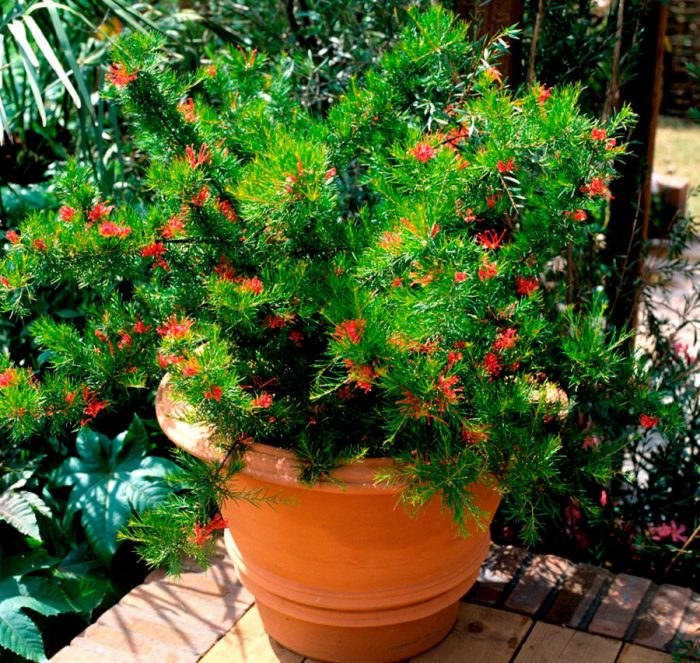
From mid-spring to October, watered abundantly. The potting medium should be slightly damp at all times. With the onset of the winter period, watering is much less frequent and less, however, care must be taken to ensure that the soil does not dry out completely.
For irrigation, use exclusively settled, soft water at room temperature.
Humidity
High humidity is required. In this regard, it is recommended to spray the plant very often, and you can also use a household steam generator. If the humidity is too low, yellowing and drying of the foliage begins. And after that, the leaves begin to die off.
Pruning
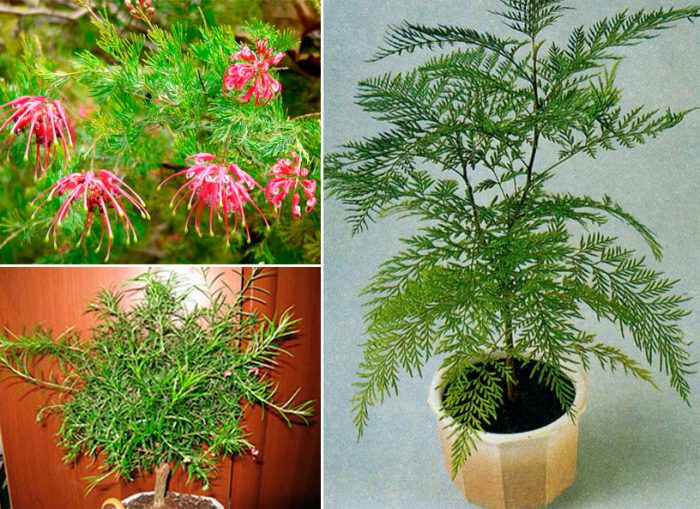
This plant is fast growing and quite large in size. Regular pruning, as well as frequent pinching of the tips of the stems, will help form a compact tree with a spectacular and very neat crown. It will also help contain the growth of large Grevillea.
Earth mixture
The soil suitable for planting should be loose, slightly acidic and rich in nutrients. To create a suitable soil mixture, it is necessary to combine coniferous, leaf and peat soil, as well as river coarse sand in a ratio of 2: 1: 1: 0.5. It is also advised to add a little crushed charcoal or brick chips to the mixture. A good drainage layer is laid at the bottom, which will avoid stagnation of liquid in the soil.
Fertilizer
They begin to feed the plant at the beginning of the spring, and end in the middle of the autumn.Top dressing is carried out 2 times a month, using a complex fertilizer for deciduous indoor plants. In autumn and winter, fertilizers cannot be applied to the soil.
Transplant features

Until the age of three, the transplant is carried out once a year. Adult specimens are transplanted 1 time in 2 or 3 years. If the plant is very large, then it should not be transplanted, but simply once a year the top layer of the substrate (up to the root system) is removed in the pot and replaced with a fresh one. This must be done carefully enough.
Reproduction of grevillea
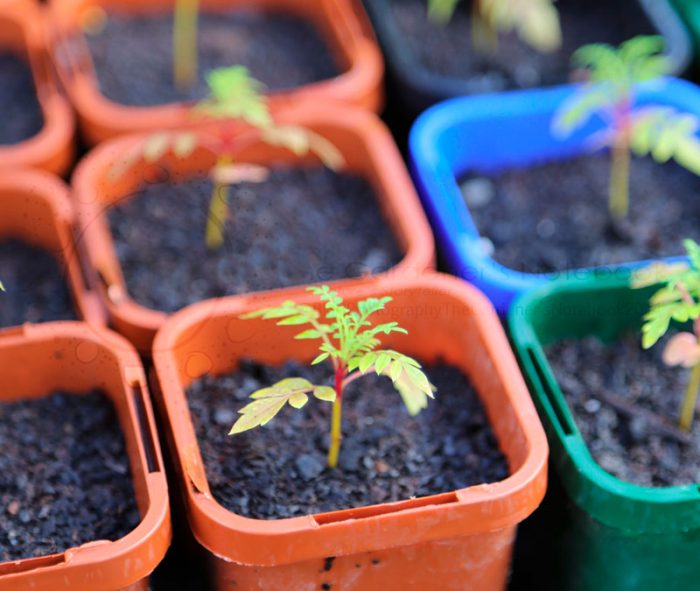
It can be propagated by semi-lignified cuttings or seeds.
Cuttings are carried out in the month of August. To do this, cut off the upper part of the shoots, which have 2 or 3 internodes. The slices are dipped in a rooting agent, and then planted in a container with moistened sand, and covered with a glass jar or a plastic bag cap. After rooting, they are transplanted into separate, not very large pots.
Seeds are sown in the last winter weeks. To do this, use low wide bowls, which are recommended to be placed in mini-greenhouses with bottom heating. Also, backlighting is required for germination.
Grevillea from seeds in 6 months | Grevillea from seeds
Diseases and pests
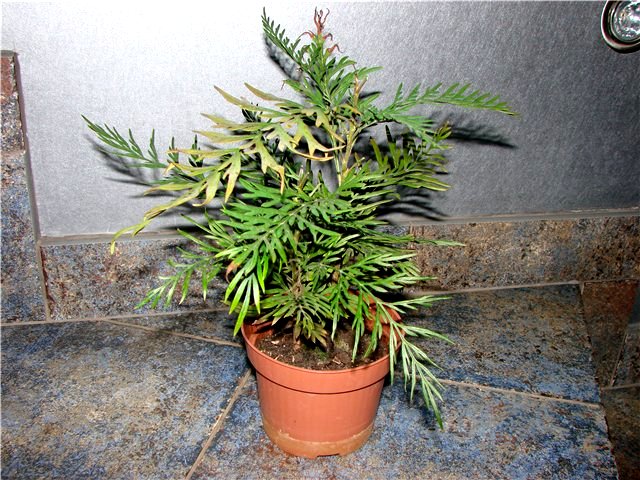
Harmful insects on such a plant can be seen extremely rarely.
This tree can get sick if it is improperly looked after. For example, if the humidity is too low, improper watering, high air temperature, and more.

